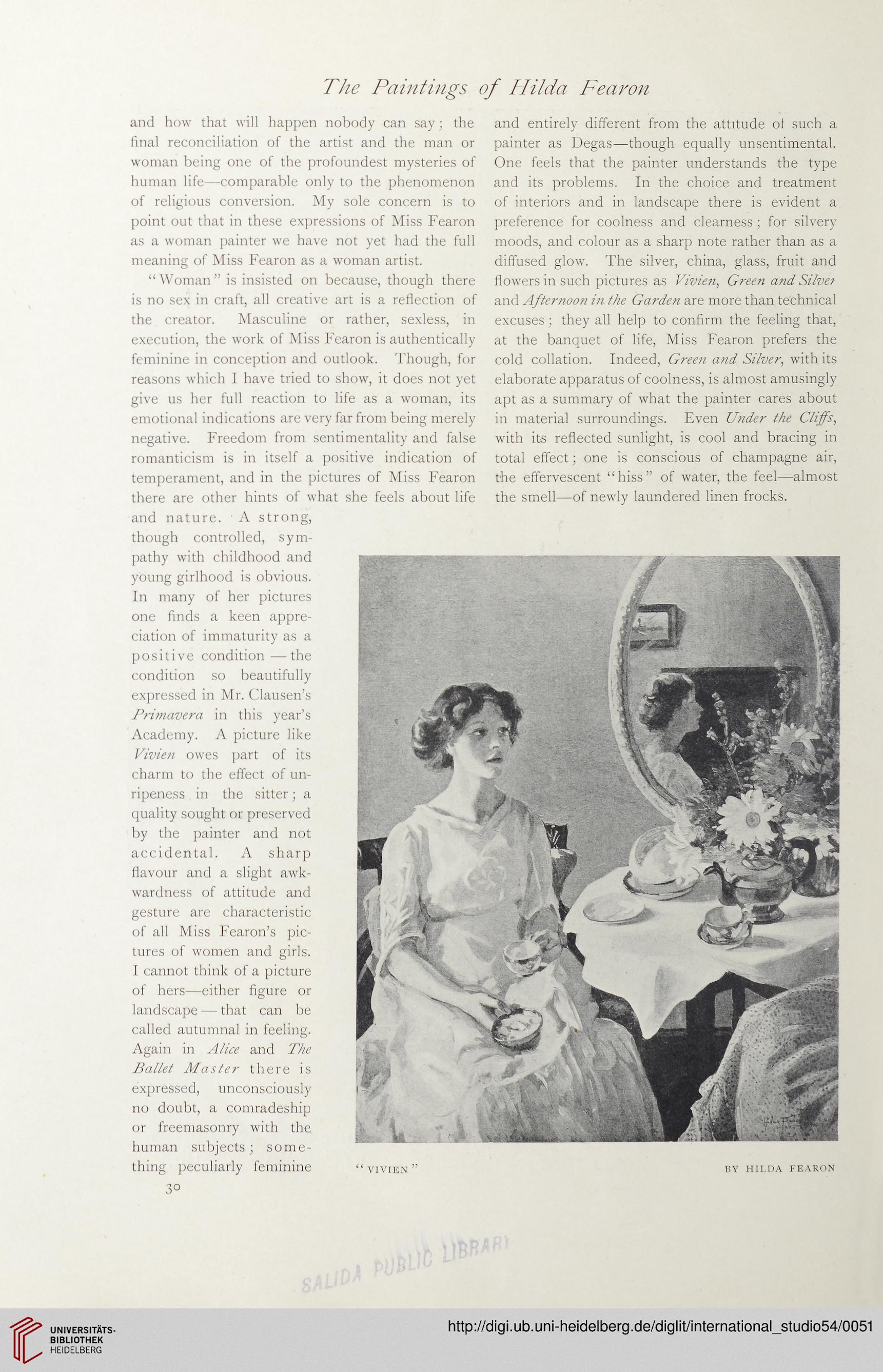The Paintings of Hilda Fearon
and how that will happen nobody can say; the
final reconciliation of the artist and the man or
woman being one of the profoundest mysteries of
human life—comparable only to the phenomenon
of religious conversion. My sole concern is to
point out that in these expressions of Miss Fearon
as a woman painter we have not yet had the full
meaning of Miss Fearon as a woman artist.
“Woman” is insisted on because, though there
is no sex in craft, all creative art is a reflection of
the creator. Masculine or rather, sexless, in
execution, the work of Miss Fearon is authentically
feminine in conception and outlook. Though, for
reasons which 1 have tried to show, it does not yet
give us her full reaction to life as a woman, its
emotional indications are very far from being merely
negative. Freedom from sentimentality and false
romanticism is in itself a positive indication of
temperament, and in the pictures of Miss Fearon
there are other hints of what she feels about life
and nature. ' A strong,
though controlled, sym¬
pathy with childhood and
young girlhood is obvious.
In many of her pictures
one finds a keen appre¬
ciation of immaturity as a
positive condition —the
condition so beautifully
expressed in Mr. Clausen’s
Primavera in this year’s
Academy. A picture like
Vivien owes part of its
charm to the effect of un¬
ripeness in the sitter; a
quality sought or preserved
by the painter and not
accidental. A sharp
flavour and a slight awk¬
wardness of attitude and
gesture are characteristic
of all Miss Fearon’s pic¬
tures of women and girls.
I cannot think of a picture
of hers—either figure or
landscape — that can be
called autumnal in feeling.
Again in Alice and The
Ballet Master there is
expressed, unconsciously
no doubt, a comradeship
or freemasonry with the
human subjects; some¬
thing peculiarly feminine
and entirely different from the attitude of such a
painter as Degas—though equally unsentimental.
One feels that the painter understands the type
and its problems. In the choice and treatment
of interiors and in landscape there is evident a
preference for coolness and clearness; for silvery
moods, and colour as a sharp note rather than as a
diffused glow. The silver, china, glass, fruit and
flowers in such pictures as Vivien, Green and Silvei
and Afternoon in the Garden are more than technical
excuses; they all help to confirm the feeling that,
at the banquet of life, Miss Fearon prefers the
cold collation. Indeed, Green and Silver, with its
elaborate apparatus of coolness, is almost amusingly
apt as a summary of what the painter cares about
in material surroundings. Even Under the Cliffs,
with its reflected sunlight, is cool and bracing in
total effect; one is conscious of champagne air,
the effervescent “hiss” of water, the feel—almost
the smell—of newly laundered linen frocks.
“ VIVIEN ”
BY HILDA FEARON
3°
and how that will happen nobody can say; the
final reconciliation of the artist and the man or
woman being one of the profoundest mysteries of
human life—comparable only to the phenomenon
of religious conversion. My sole concern is to
point out that in these expressions of Miss Fearon
as a woman painter we have not yet had the full
meaning of Miss Fearon as a woman artist.
“Woman” is insisted on because, though there
is no sex in craft, all creative art is a reflection of
the creator. Masculine or rather, sexless, in
execution, the work of Miss Fearon is authentically
feminine in conception and outlook. Though, for
reasons which 1 have tried to show, it does not yet
give us her full reaction to life as a woman, its
emotional indications are very far from being merely
negative. Freedom from sentimentality and false
romanticism is in itself a positive indication of
temperament, and in the pictures of Miss Fearon
there are other hints of what she feels about life
and nature. ' A strong,
though controlled, sym¬
pathy with childhood and
young girlhood is obvious.
In many of her pictures
one finds a keen appre¬
ciation of immaturity as a
positive condition —the
condition so beautifully
expressed in Mr. Clausen’s
Primavera in this year’s
Academy. A picture like
Vivien owes part of its
charm to the effect of un¬
ripeness in the sitter; a
quality sought or preserved
by the painter and not
accidental. A sharp
flavour and a slight awk¬
wardness of attitude and
gesture are characteristic
of all Miss Fearon’s pic¬
tures of women and girls.
I cannot think of a picture
of hers—either figure or
landscape — that can be
called autumnal in feeling.
Again in Alice and The
Ballet Master there is
expressed, unconsciously
no doubt, a comradeship
or freemasonry with the
human subjects; some¬
thing peculiarly feminine
and entirely different from the attitude of such a
painter as Degas—though equally unsentimental.
One feels that the painter understands the type
and its problems. In the choice and treatment
of interiors and in landscape there is evident a
preference for coolness and clearness; for silvery
moods, and colour as a sharp note rather than as a
diffused glow. The silver, china, glass, fruit and
flowers in such pictures as Vivien, Green and Silvei
and Afternoon in the Garden are more than technical
excuses; they all help to confirm the feeling that,
at the banquet of life, Miss Fearon prefers the
cold collation. Indeed, Green and Silver, with its
elaborate apparatus of coolness, is almost amusingly
apt as a summary of what the painter cares about
in material surroundings. Even Under the Cliffs,
with its reflected sunlight, is cool and bracing in
total effect; one is conscious of champagne air,
the effervescent “hiss” of water, the feel—almost
the smell—of newly laundered linen frocks.
“ VIVIEN ”
BY HILDA FEARON
3°




